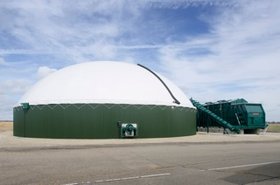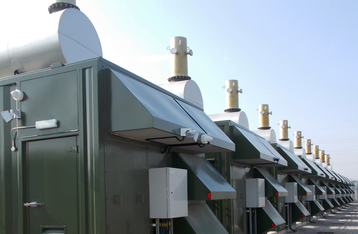Many data center operators are now publicly committed to achieving net-zero carbon emissions by 2030 or 2035. But genuinely achieving that is going to be a major challenge.
In many respects, therefore, achieving true net-zero will be more of an evolution, than a revolution – a long journey with multiple stops, rather than a destination reached in no time at all.
One of the stops along the way will be the phasing out of diesel back-up generators and replacing them with cleaner, less carbon-intensive solutions. But battery technology is a long way from taking over that role: while a UPS can keep a data center running on battery power for minutes, the technology to keep it up-and-running for days on end wouldn’t be economical even if it were technically feasible.
Instead, therefore, natural gas is taking a growing share of the data center backup market from diesel, and not just for improved sustainability.
Natural gas generators can be connected to the grid, so don’t require a fuel tank, and should therefore not have any refuelling difficulties during a prolonged outage. And natural gas will be unaffected by the coldest of winters, even if the data center were located on Antarctica1.
“Demand for gas is increasing due to the steadily tightening emissions regulations being introduced across the world,” says Manuel Scherb, Head of Team CSE at Aprovis, a high-tech company specialising in exhaust after treatment, filters, exhaust gas heat exchangers, catalytic converters, silencers and much more.
And it’s not purely about emissions, but rising concern over the impact of the concentration of data centers in particular areas. Should the power go down, they’ll likely all be running on backup, generating noise as well as diesel particulates, and this has become an even bigger issue with the encroachment of data centers into sensitive residential areas.
However, gas backup generators – unlike diesel – don’t just provide backup, but greater flexibility and security. For example, they can also be used to provide revenue-generating grid-balancing services to grid operators, helping to reduce their cost, while providing a service that helps support the adoption of renewable power.
But to take advantage, data center operators will need to ensure their gas backup generators are as quiet as they can be, while keeping emissions to the absolute minimum possible.
Natural gas isn’t just comprised of pure methane, but other compounds that mean that when it is combusted, in addition to carbon monoxide, it also generates nitrogen oxides (NOx), carbon dioxide (CO2), nitrous oxide (N2O), formaldehyde (HCHO), volatile organic compounds (VOCs), trace amounts of sulfur dioxide (SO2), and particulates – albeit not in anything like the same quantities as diesel2.
That’s where companies like Aprovis with its exhaust after treatment technologies come in. “Our equipment is used for emission reduction and noise attenuation,” says Scherb. “So our focus is on the complete exhaust gas system after engine.”
While catalytic converters are well-established in motor vehicles, they are also required on diesel and gas-based backup generators in order to reduce the exhaust of noxious fumes. For gas backup, that means reducing the amount of carbon monoxide and formaldehyde, in particular, in the combustion exhaust gases.
On top of that, data center operators in the European Union, under a 2015 directive, [3] are also required to reduce their generators’ SO2 and NOx emissions, as well. That means that operators must deploy selective catalytic reduction (SCR) catalytic converters, too, in order to comply. The EU directive doesn’t target the data center industry specifically, but applies to operators of medium-sized combustion plants with an output from one to 50 MW of combustion heat.
SCR catalytic converters, like Euro6-compliant diesel vehicles, use a Urea solution (better known as AdBlue) that reacts with hot exhaust gas to form ammonia. When the resulting concoction hits the SCR catalytic converter, the ammonia (NH3) and the NOx are turned into a combination of nitrogen and water.
For diesel backup generators, the addition of a particulate filter in front of the SCR catalytic converter will help improve the efficiency of the process, in addition to reducing the generation of soot and dust particles in the diesel exhaust gas.
Silence is golden
Aprovis’s technology also includes silencers designed to reduce sound pollution, covering the entire sound spectrum. It offers both silencers based on conventional reflective materials, which reduce low- and medium-range frequency sound, as well as absorption-based silencers, which excel at reducing medium-to-high frequency sound.
Better still, perhaps, are silencers based on a combination of both technologies, which can be fitted to both gas and diesel backup generators, as well as retro-fitted. “Noise regulations are increasing globally, so we are also replacing or doing retrofits all over the world as a result,” says Scherb. “Aprovis also takes into account the influence of the catalytic converter or diesel particulate filter [if it’s fitted to a diesel backup generator],” he continues.
Even better than that, Aprovis also offers silencers with integrated catalytic converters intended to combine the best of both technology categories in one space-saving solution.
These are not necessarily off-the-shelf solutions. Rather, the range of supplementary components that can be fitted – exhaust gas heat exchangers, steam generators, catalytic converters and silencers – means that they need to be individually optimised according to site requirements (especially if planning permits are stringent) and the backup generation that will be used.
Furthermore, with planners increasingly expecting data centers to recycle heat to make them even more sustainable, gas-powered backup engines could also be fitted with heat exchangers and steam generators, both of which Aprovis also supplies.
A heat exchanger can be used to more efficiently generate hot water, regardless of the type of fuel generating the exhaust gas – hydrogen, natural gas, biogas, sewage gas and special gases, as well as diesel and other liquid fossil fuels.
However, it might not be economically viable for data center operators to use such technology with diesel and other liquid fossil fuels as they will only have been mandated for use for emergency backup. Gas backup, on the other hand, might also be used to provide grid-balancing services for utilities and might, therefore, be used frequently enough to make them an economically viable addition.
While shifting from diesel to gas might earn a few hard stares from Greta Thunberg – it is, after all, still a fossil fuel – it is nevertheless still cleaner and quieter, with lower CO2 emissions. Exhaust treatments can make gas even cleaner and quieter.
Furthermore, not only can fitting catalytic converters, silencers, heat exchangers, and steam generators make gas-based backup generators a better option for anyone living in the vicinity of data centers, but heat re-use can help make data centers still more sustainable.
References:
- The coldest Antarctic temperature ever recorded is -94.7 degrees celsius in August 2010, while methane gas, the main constituent of natural gas, turns liquid at around -160 degrees celsius
- ‘Natural Gas Combustion’ – US Environmental Protection Agency [PDF]
More...
-

Will natural gas replace diesel as a data center power source?
Natural Gas (NG) generators are becoming cost competitive with diesel generators and have a better greenhouse gas emission profile
-

A week in climate change
Exploring a terrible week for the planet, and what it means for data centers
-

Strange bedfellows: new data center locations
Build near a complementary industry, and a data center can go from a liability to an environmental asset


